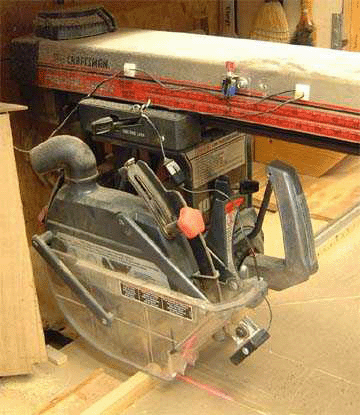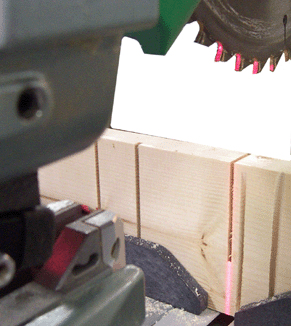
Tom Walker was thrilled to finally buy a brand-new, laser-equipped radial arm saw! It was the kind of technological advance he’d always wanted. But when he tried to use it, it just didn’t perform. Now most of us, at that point, would have to content ourselves with waiting for the technology to improve. Not Tom Walker.
With a background in manufacturing, engineering, and quality assurance, he decided to make something that would work and soon created his own laser system – installing it on an older radial arm saw. That gave him the results he wanted, but he didn’t stop there.
“It was just last fall, about a year ago,” Tom recalled. “It worked really well, and when I showed it to a friend of mine, he liked it, so I made him one. And then made another one for another guy. Then I took off the one that came with my new radial arm saw and put mine on!”
When he started, Tom had no intention of going into manufacturing for himself. In fact, at the time, he was taking classes to become a webmaster. The plant where he worked in Georgetown, Kentucky, had closed.
“But then I decided to give it a shot and made an inventory of the lasers and took my saws to a woodworking show in the Detroit area. I was pretty much scared to death & people might just pass me by. But it was well received, got some good comments, and I sold a bunch. We did a few more woodworking shows, and the web site went up in March of this year.”
The shows proved to be too time intensive, so Tom switched his marketing efforts to advertising and online sales. And according to Tom, it’s been a good decision.
Even with the growth of sales, the whole operation is Tom and some part-time help. Yet he still finds time for RandD & developing different models and accessories to retrofit the widest variety of radial arm saws and miter saws.
“I buy and sell saws all the time.” Tom explained, “I buy one to get the laser to fit and then sell the saw.”
With manufacturing firmly in hand, learning to market his lasers has been a continuous process for Tom. He gets some help from a son-in-law who’s a VP of marketing for a web company in nearby Louisville. Through e-mail, he’s managed to develop a couple of retail outlets, one in Canada and one in New York. And his webmaster training has helped him set up his web site, which offers both online and phone ordering.

The Laserkerf web site lists all the radial arm saws and miter saws compatible with one of his laser models. Depending on the model and the requirements of the woodworker, the laser comes in two different beam widths, a vertical or horizontal orientation, and battery or AC current. The primary limitation on retrofitting a saw is the clearance on a 45-degree cut. Laserkerf only requires 1 3/8″ and easily fits onto the large DeWalt, Makita, Hitachi, and Ridgid models, but a few smaller saws just don’t offer the clearance. Once Tom works out the configuration, installation is relatively simple.
“It’s attached using a permanent acrylic adhesive,” noted Tom. “It’s made by 3M and pretty much industrial strength. It’s even passed a five-year outdoor test in Minnesota. Exact placement isn’t necessary because of the adjustments that can be made after it’s installed. An angular adjustment gets the beam parallel with the saw blade or a kerf that’s been cut, and the horizontal adjustment moves it left to right so it falls into the cut.”
With the AC model, the laser can stay on all the time. And as Tom explained, the red light, clearly defining just where the blade will come down, offers an additional safety factor for anyone contemplating a cut.
Besides adding more models for more saws, he plans to introduce other tools designed to further increase the accuracy of saws. He’s just unveiled a tool that checks a saw’s cutting angles. Miter-Pal is a one-inch thick, five-inch long triangle of steel with a 90-degree angle at one end and a 45 at the other. When attached to the blade with a spring-loaded clamp, it leaves your hands free to set the angle to within a quarter of a degree.
After years of living around the world, first in the military and then working in manufacturing, Tom and his wife moved back to her native Kentucky to plant some roots and settle down. All he wanted was a decent laser-guided radial arm saw. But developing and manufacturing the Laserkerf, doing the R&D, marketing, and making sure every order is shipped within 24 hours has kept Tom busier than ever!





